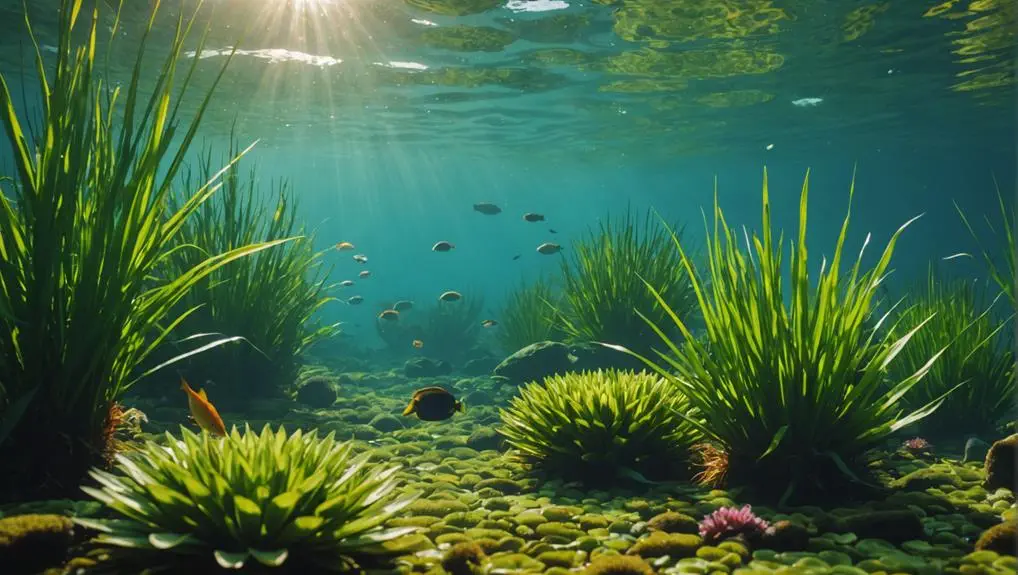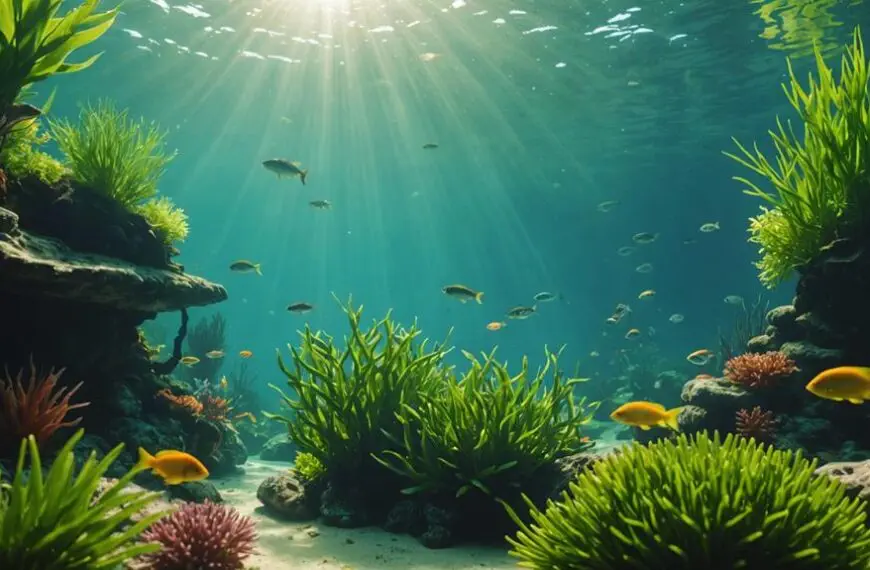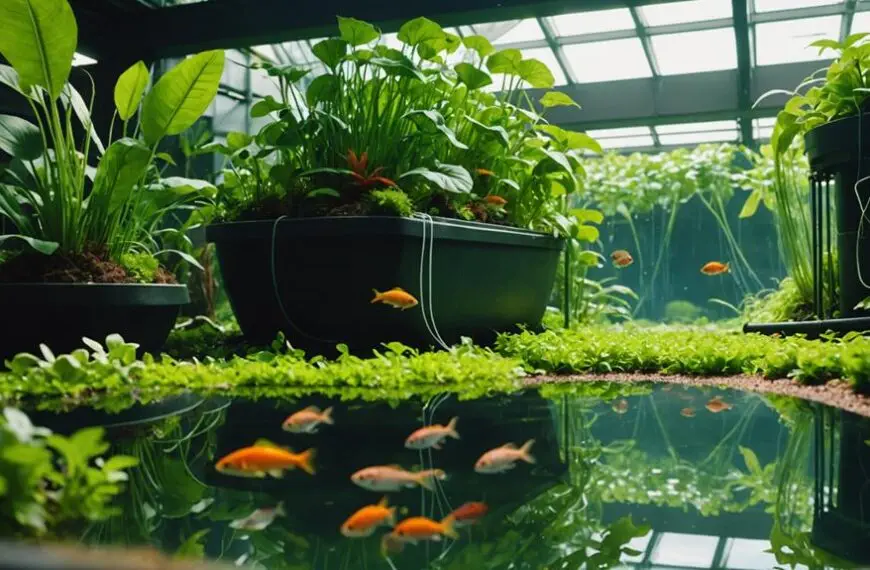If you want to enhance fish habitats, consider planting sustainable aquatic plants like Texas wild-rice and seagrasses, such as eelgrass. These green gems not only provide food and shelter for fish, but they also keep the water clean and healthy. They act like nature's mini vacuum cleaners, absorbing nutrients and preventing pollution. Plus, their deep roots stabilize soil and prevent erosion—a win-win! By creating a cozy underwater home, you can boost fish productivity significantly. Curious about other plants and more tips? Stick around, because there's plenty more to explore about making our waters even friendlier for fish!
Contents
- 1 Benefits of Sustainable Plants
- 2 Types of Native Aquatic Plants
- 3 Role of Plants in Water Quality
- 4 Enhancing Fish Habitats With Vegetation
- 5 Erosion Control Through Planting
- 6 Supporting Biodiversity in Aquatic Ecosystems
- 7 Sustainable Gardening Practices for Fish
- 8 Community Involvement in Planting Efforts
- 9 Resources for Choosing Sustainable Plants
- 10 Frequently Asked Questions
- 11 Final Thoughts
Benefits of Sustainable Plants
Sustainable plants play a crucial role in enhancing fish habitats and overall aquatic ecosystems. When you choose native aquatic plants, you're not just beautifying your pond or riverbank; you're actively improving water quality.
These plants absorb excess nutrients and filter out pollutants, creating a healthier environment for fish to thrive. This is particularly important because optimal conditions for fish health help reduce stress and illness in aquatic populations. Plus, deep-rooted native species help prevent erosion, keeping sediment from smothering those precious fish habitats.
But it doesn't stop there! Native vegetation provides essential shelter and spawning grounds.
Imagine a bustling community of fish, all thanks to your thoughtful planting choices. Studies show that using native plants can even boost fish productivity dramatically — by nearly 10 tonnes of commercial fish per hectare each year!
And let's not overlook the practical side. Sustainable gardening with native plants means lower water usage and maintenance costs.
You'll be supporting local wildlife while creating a resilient ecosystem that benefits everyone, including those fish. So, when you plant those native beauties, remember you're not just adding greenery; you're cultivating a thriving underwater paradise!
Now, how's that for making a splash?
Types of Native Aquatic Plants
Choosing the right native aquatic plants can significantly enhance fish habitats and the overall health of aquatic ecosystems. Imagine a lively underwater world where fish species thrive, thanks to helpful plants like Texas wild-rice (Zizania texana). This plant isn't just a pretty face; it provides food, shelter, and cozy spawning areas for various fish, making it a gem for fisheries management.
Don't forget about seagrasses like Zostera marina! These coastal heroes support fisheries by creating critical habitats while also improving water quality. It's like they're saying, "Hey fish, come on over! We've got everything you need!"
You might also encounter eelgrass and hydrilla, which recycle nutrients and can boost commercial fish harvest by nearly 10 tonnes per hectare annually. That's a lot of fish tacos!
Across Texas, native aquatic plant nurseries are sprouting up, focusing on over 20 beneficial species. By planting these native aquatic plants, you're not only reducing shoreline erosion but also fostering a vibrant ecosystem.
Role of Plants in Water Quality
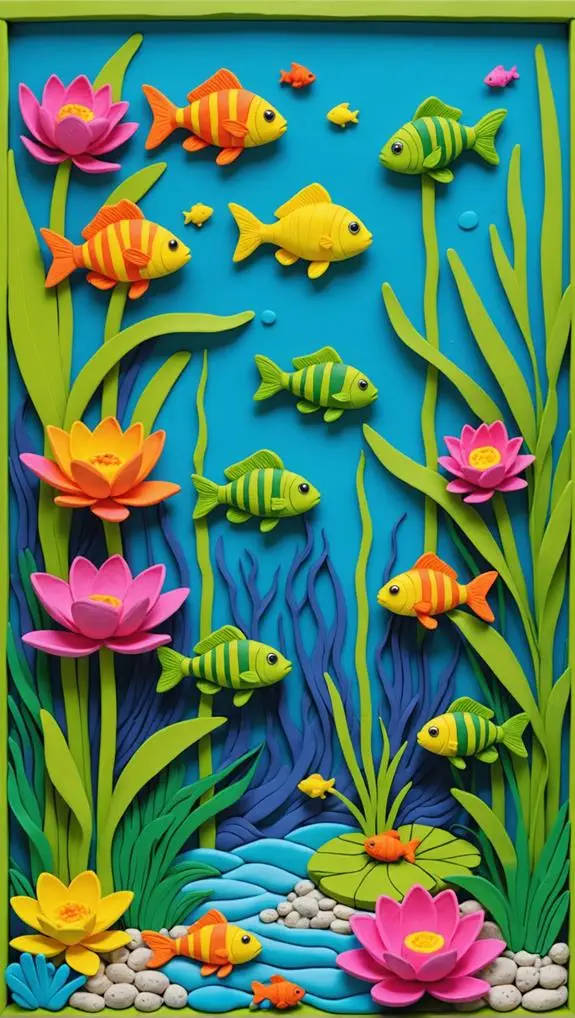
Plants in water bodies aren't just pretty to look at; they're like nature's little superheroes for water quality!
By filtering out pollutants and stabilizing soil structures, these green wonders keep the water clean and healthy.
Plus, they enhance oxygen levels, making it a great party for fish and other aquatic life—who wouldn't want to hang out in such a lively environment?
Filtering Pollutants Effectively
When it comes to improving water quality, aquatic plants play a crucial role in filtering pollutants effectively.
They're like nature's little cleaners, helping keep our waterways healthy for fish and other creatures. If you want to support these amazing plants, consider visiting a native plant nursery.
Here are three ways aquatic plants help filter pollutants:
- Nutrient Absorption: Plants like seagrasses absorb excess nutrients, which helps reduce the risk of eutrophication—an event that can suffocate aquatic life.
- Sediment Stabilization: By stabilizing sediments, plants prevent toxic substances from clouding the water and harming fish populations. Think of them as the guardians of the underwater world!
- Pollution Interception: Creating vegetation buffer zones around water bodies allows plants to intercept runoff pollution, leading to cleaner water entering habitats.
Enhancing Oxygen Levels
Aquatic vegetation significantly boosts oxygen levels in water bodies, making it essential for maintaining a healthy ecosystem. When you think about it, these plants, like seagrasses and submerged macrophytes, are like nature's little oxygen factories. Through photosynthesis, they not only enhance oxygen levels but also improve overall water quality, which is vital for fish health.
You might be surprised to learn that healthy plant communities can even combat the dreaded eutrophication! This phenomenon occurs when nutrient runoff causes excessive algal blooms, which deplete oxygen and suffocate fish. By incorporating native plant species into your local water bodies, you can help stabilize sediments, reduce turbidity, and allow sunlight to penetrate, giving these plants the chance to thrive.
Dense growth of aquatic vegetation can increase dissolved oxygen levels by up to 5 mg/L. That's a significant boost for fish populations, especially during their critical growth stages.
So, by promoting aquatic plants, you're not just enhancing oxygen levels; you're also creating a nurturing habitat for fish to flourish.
Stabilizing Soil Structures
Stabilizing soil structures is crucial for maintaining healthy aquatic environments, and native vegetation plays a key role in this process. When you plant native species, you're not just beautifying your space; you're also helping to create a thriving habitat for fish and other wildlife.
Here's how native plants contribute to this vital task:
- Deep Root Systems: Native plants have roots that dig deep into the soil, which helps hold it together and prevents erosion. This is especially important for keeping gravel beds clean for salmon spawning.
- Water Quality Improvement: These plants filter out pollutants and contribute to nutrient cycling, which means cleaner water for your fishy friends.
- Shade Provision: By providing shade near waterways, native vegetation helps keep water temperatures cool, making it a comfy home for various fish species.
When invasive plants take over with their shallow roots, they can cause soil erosion and jeopardize water quality.
Enhancing Fish Habitats With Vegetation
When you think about enhancing fish habitats, native plants like Texas wild-rice and eelgrass are game-changers.
Not only do they offer fish a cozy place to hide and snack, but they also help keep the water clean and clear.
Plus, by planting these green heroes along riverbanks, you're giving erosion the boot, making sure fish have a safe and stable home to thrive in!
Native Plant Benefits
Enhancing fish habitats with native plants offers numerous benefits that are crucial for maintaining healthy aquatic ecosystems. When you introduce native plants into your area, you're not just beautifying the space; you're creating a thriving environment for fish and other wildlife.
Here are three key benefits of using native plants in your fish habitat efforts:
- Food and Shelter: Native plants, like Texas wild-rice, provide essential food, shelter, and spawning areas for fish. They create a cozy home for aquatic life.
- Soil Stabilization: The deep roots of native vegetation stabilize soil, helping to reduce erosion and turbidity. This means clearer water and healthier fish populations.
- Biodiversity Boost: By supporting diverse aquatic plant communities, native plants cater to the lifecycle needs of various fish species. Healthy biodiversity leads to stronger ecosystems.
Using native plants not only promotes sustainability but also eases maintenance and water usage. You can feel good knowing that your efforts help improve fish habitats while supporting the environment.
Erosion Control Strategies
Erosion control is essential for maintaining healthy fish habitats, and employing effective strategies can make a significant difference. When you plant native species along riverbanks, you're not just beautifying the area; you're also stabilizing the soil. These plants have deep roots that help hold everything together, reducing erosion and keeping those clean gravel beds intact—crucial for salmon spawning.
Who knew that a little greenery could be a fish's best friend, right?
By incorporating native vegetation, you can also reduce surface runoff, which prevents sediment from clouding the water. This means fish can swim happily without dodging debris. Plus, planting native species like Texas wild-rice provides shelter and food, boosting biodiversity in the area. It's like hosting a buffet for fish and wildlife habitat!
Effective erosion control strategies also help filter out pollutants before they reach our precious waterways, supporting healthier fish populations.
So, by taking these simple steps, you're not just helping the fish; you're fostering a vibrant ecosystem. You're making a positive impact, and that's something to be proud of.
Let's roll up our sleeves and get planting—you've got this!
Erosion Control Through Planting
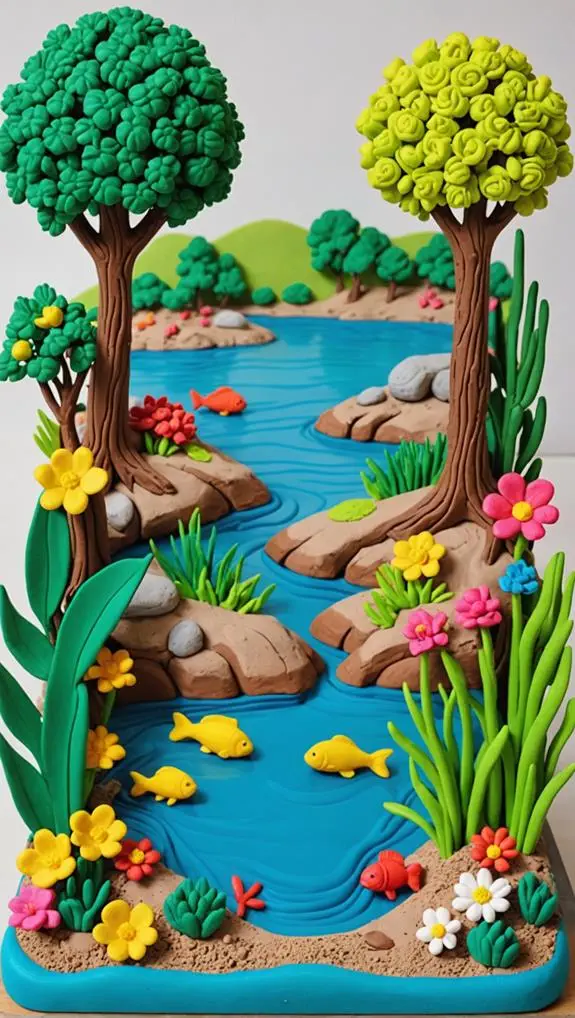
Effective erosion control is crucial for maintaining healthy aquatic ecosystems, and planting native vegetation plays a vital role in this process.
By choosing the right plant species, you can help stabilize soil and protect vital aquatic habitats. Here are three ways planting can make a difference:
- Deep Root Systems: Plants like willows and dogwoods have extensive root systems that anchor soil effectively. This prevents erosion along riverbanks and shorelines, keeping sediments in place.
- Natural Barriers: By establishing vegetation, you create natural barriers against wind and water flow. These green buffers help reduce the physical forces that lead to soil loss, making it less likely for sediment to wash away.
- Riparian Buffers: Creating riparian zones filled with native plants not only controls erosion but also filters pollutants, enhancing water quality in aquatic environments.
Cleaner water means healthier habitats for fish and other aquatic life.
Supporting Biodiversity in Aquatic Ecosystems
Planting native vegetation not only stabilizes soil but also plays a key role in supporting biodiversity within aquatic ecosystems.
When you introduce native plant communities, like seagrasses and water lilies, you create essential habitats for fish. These plants provide food, shelter, and spawning areas, making it easier for fish to thrive. Plus, they help improve water quality by absorbing excess nutrients and reducing the impacts of eutrophication. Talk about a win-win!
Aquatic vegetation, such as Texas wild-rice, does more than just look pretty; it stabilizes riverbanks, preventing erosion and keeping those clean gravel beds intact for fish to spawn.
Imagine all those little fish making their homes in diverse native plants! Research shows that having a variety of native plants leads to an increase in fish species richness, which means healthier fish communities overall.
Sustainable Gardening Practices for Fish
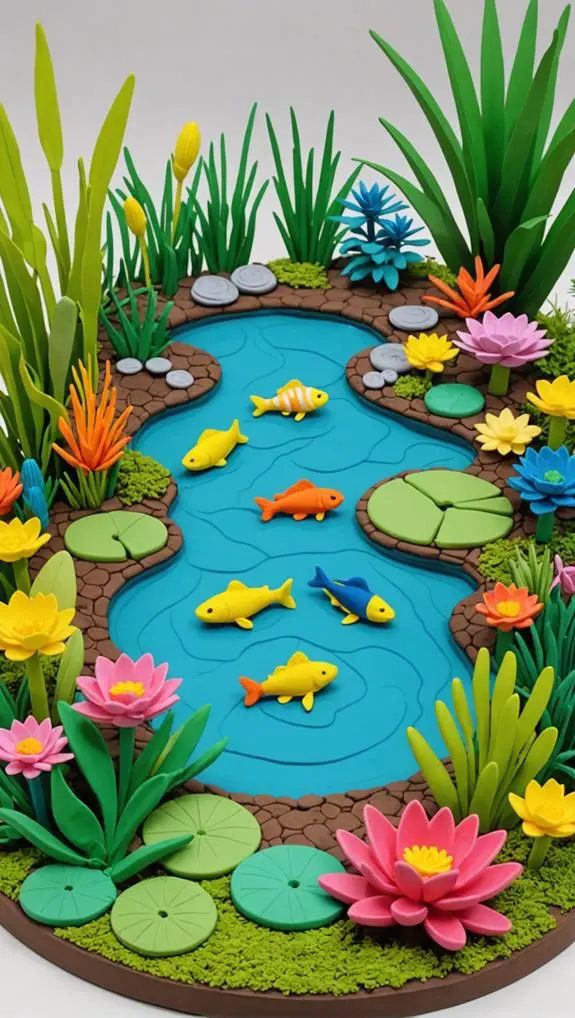
Transform your garden into a thriving ecosystem that benefits both plants and fish by incorporating sustainable gardening practices. Not only do these practices enhance your landscape, but they also support freshwater fisheries and help aquatic species flourish.
Here are three effective ways to get started:
1. Choose Native Plants: Native plants provide essential food and shelter for fish and other wildlife. They're like a buffet for local fauna, ensuring vibrant habitat diversity.
2. Implement Eco-Friendly Techniques: By using organic pest management and reducing fertilizer use, you minimize harmful runoff.
This keeps waterways clean and protects aquatic ecosystems, which is vital for fish survival.
3. Create Rain Gardens: These gardens filter stormwater runoff and recharge groundwater, maintaining clean water sources.
Think of them as nature's water purifiers, providing optimal conditions for fish and their aquatic buddies.
Community Involvement in Planting Efforts
When you involve your community in planting efforts, the impact on local fish habitats can be profound. By bringing people together, you not only boost restoration projects but also tap into valuable local knowledge. This sense of ownership encourages everyone to care for their environment.
Engaging volunteers in native plant nurseries has helped cultivate over 20 beneficial species that enhance habitats, especially in Texas reservoirs. Furthermore, maintaining optimal water quality is essential for supporting healthy fish populations, ensuring that the plants and aquatic life thrive together.
Collaborative projects, like those led by the Texas Parks and Wildlife Department, show how community involvement is key in installing native vegetation. These plants are critical for improving fish habitats and can help local fisheries thrive.
Plus, educational programs raise awareness about the ecological benefits of native species, encouraging sustainable gardening practices that everyone can adopt.
When successful community-led initiatives take root, they improve biodiversity and stabilize ecosystems, creating safe havens for various fish species.
Resources for Choosing Sustainable Plants
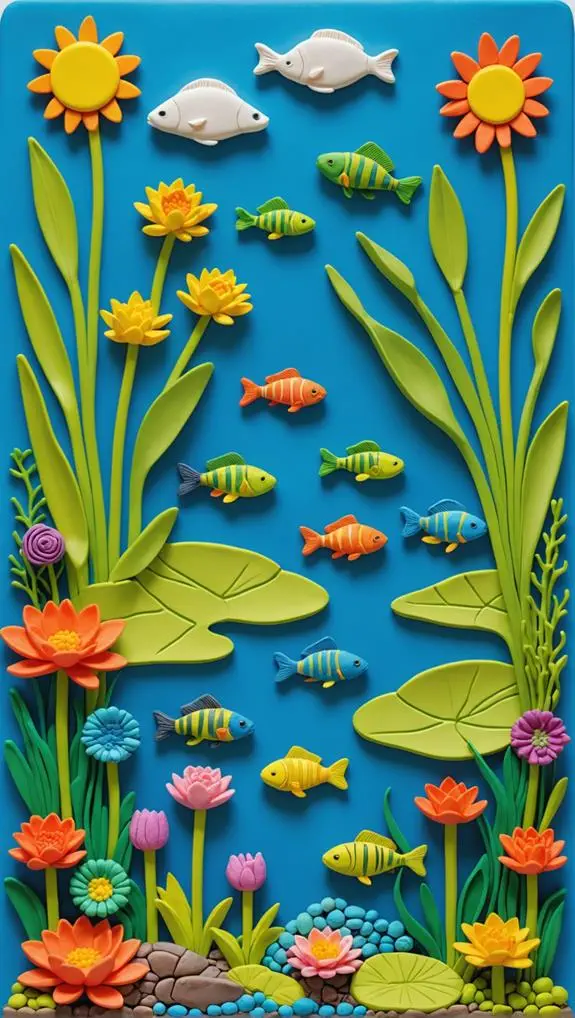
Choosing the right sustainable plants can significantly enhance fish habitats, making the efforts of your community even more impactful.
By selecting native plants, you not only help improve water quality but also create shelter, spawning areas, and food sources for fish.
Here are three resources to guide you in your selection:
1. Texas Parks and Wildlife Department (TPWD): They've cultivated over 20 native aquatic plant species specifically for reservoir habitats.
Check out their website for valuable information on which plants best support biodiversity.
2. Seeds for Salmon Brochure: This handy resource provides guidance on selecting native plants that enhance fish habitats while promoting ecosystem health.
It's a great starting point for your planting journey!
3. Local Organizations: Engage with community groups that focus on sustainable gardening.
They often offer workshops and educational materials to help you propagate native plants effectively in aquatic settings.
Frequently Asked Questions
What Is the Most Sustainable Source of Fish?
When you're choosing the most sustainable source of fish, consider supporting locally sourced seafood and sustainable aquaculture practices. Engaging with community fishing initiatives ensures you contribute to healthier ecosystems and stronger local economies.
What Makes a Good Habitat for Fish?
A good fish habitat combines diverse vegetation types and strong habitat structure. These elements enhance water quality, providing food and shelter, while promoting healthy ecosystems where fish can thrive and communities can enjoy sustainable fishing opportunities.
What Is the Best Homemade Fish Habitat?
So you wanna be the fish whisperer, huh? Try crafting DIY fish shelters from natural materials, and don't forget your aquatic plant selection for that fabulous habitat design—your fish will thank you with happy little splashes!
How to Protect Fish Habitats?
To protect fish habitats, you can restore native vegetation, which improves water quality and provides crucial shelter. Engage your community in these efforts, fostering a shared commitment to maintaining and enhancing aquatic environments for future generations.
Final Thoughts
By planting sustainable species, you're not just beautifying your space; you're creating a thriving fish habitat! It's like throwing a party for aquatic life—everyone's invited! Remember, healthy plants lead to cleaner water and happier fish. Plus, when you get involved with your community, you're making a big splash for biodiversity. So, roll up your sleeves, dig in, and let's make our waters a greener, healthier place, one plant at a time!

